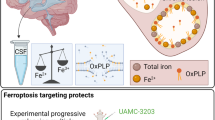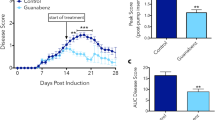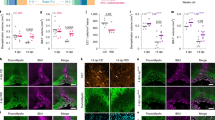Abstract
Statins, 3-hydroxy-3-methylglutaryl coenzyme A (HMG-CoA) reductase inhibitors, which are approved for cholesterol reduction, may also be beneficial in the treatment of inflammatory diseases1,2,3. Atorvastatin (Lipitor) was tested in chronic and relapsing experimental autoimmune encephalomyelitis, a CD4+ Th1-mediated central nervous system (CNS) demyelinating disease model of multiple sclerosis4,5. Here we show that oral atorvastatin prevented or reversed chronic and relapsing paralysis. Atorvastatin induced STAT6 phosphorylation and secretion of Th2 cytokines (interleukin (IL)-4, IL-5 and IL-10) and transforming growth factor (TGF)-β. Conversely, STAT4 phosphorylation was inhibited and secretion of Th1 cytokines (IL-2, IL-12, interferon (IFN)-γ and tumour necrosis factor (TNF)-α) was suppressed. Atorvastatin promoted differentiation of Th0 cells into Th2 cells. In adoptive transfer, these Th2 cells protected recipient mice from EAE induction. Atorvastatin reduced CNS infiltration and major histocompatibility complex (MHC) class II expression. Treatment of microglia inhibited IFN-γ-inducible transcription at multiple MHC class II transactivator (CIITA) promoters and suppressed class II upregulation. Atorvastatin suppressed IFN-γ-inducible expression of CD40, CD80 and CD86 co-stimulatory molecules. l-Mevalonate, the product of HMG-CoA reductase, reversed atorvastatin's effects on antigen-presenting cells (APC) and T cells. Atorvastatin treatment of either APC or T cells suppressed antigen-specific T-cell activation. Thus, atorvastatin has pleiotropic immunomodulatory effects involving both APC and T-cell compartments. Statins may be beneficial for multiple sclerosis and other Th1-mediated autoimmune diseases.
This is a preview of subscription content, access via your institution
Access options
Subscribe to this journal
Receive 51 print issues and online access
$199.00 per year
only $3.90 per issue
Buy this article
- Purchase on Springer Link
- Instant access to full article PDF
Prices may be subject to local taxes which are calculated during checkout





Similar content being viewed by others
References
Kobashigawa, J. A. et al. Effect of pravastatin on outcomes after cardiac transplantation. N. Engl. J. Med. 333, 621–627 (1995)
Pahan, K., Sheikh, F. G., Namboodiri, A. M. & Singh, I. Lovastatin and phenylacetate inhibit the induction of nitric oxide synthase and cytokines in rat primary astrocytes, microglia, and macrophages. J. Clin. Invest. 100, 2671–2679 (1997)
Wong, B. et al. Statins suppress THP-1 cell migration and secretion of matrix metalloproteinase 9 by inhibiting geranylgeranylation. J. Leukoc. Biol. 69, 959–962 (2001)
Zamvil, S. S. & Steinman, L. The T lymphocyte in experimental allergic encephalomyelitis. Annu. Rev. Immunol. 8, 579–621 (1990)
Slavin, A. J. et al. Requirement for endocytic antigen processing and influence of invariant chain and H-2M deficiencies in CNS autoimmunity. J. Clin. Invest. 108, 1133–1139 (2001)
Romano, M. et al. Inhibition of monocyte chemotactic protein-1 synthesis by statins. Lab. Invest. 80, 1095–1100 (2000)
Steinman, L., Rosenbaum, J. T., Sriram, S. & McDevitt, H. O. In vivo effects of antibodies to immune response gene products: prevention of experimental allergic encephalomyelitis. Proc. Natl Acad. Sci. USA 78, 7111–7114 (1981)
Bottazo, G. F., Pujol-Borrell, R., Hanufusa, T. & Feldmann, M. Role of aberrant HLA-DR expression and antigen presentation in induction of endocrine autoimmunity. Lancet 2, 1115–1119 (1983)
Kwak, B., Mulhaupt, F., Myit, S. & Mach, F. Statins as a newly recognized type of immunomodulator. Nature Med. 6, 1399–1402 (2000)
Mach, B., Steimle, V., Martinez-Soria, E. & Reith, W. Regulation of MHC class II genes: lessons from a disease. Annu. Rev. Immunol. 14, 301–331 (1996)
Muhlethaler-Mottet, A., Otten, L. A., Steimle, V. & Mach, B. Expression of MHC class II molecules in different cellular and functional compartments is controlled by differential usage of multiple promoters of the transactivator CIITA. EMBO J. 16, 2851–2860 (1997)
Maeda, A. & Sobel, R. A. Matrix metalloproteinases in the normal human central nervous system, microglial nodules, and multiple sclerosis lesions. J. Neuropathol. Exp. Neurol. 55, 300–309 (1996)
Rudick, R. A. Contemporary immunomodulatory therapy for multiple sclerosis. J. Neuroophthalmol. 21, 284–291 (2001)
Staffa, J. A., Chang, J. & Green, L. Cerivastatin and reports of fatal rhabdomyolysis. N. Engl. Med. 346, 539–540 (2002)
Bernini, F., Poli, A. & Paoletti, R. Safety of HMG-CoA reductase inhibitors: focus on atorvastatin. Cardiovasc. Drugs Ther. 15, 211–218 (2001)
Cilla, D. D. Jr, Whitfield, L. R., Gibson, D. M., Sedman, A. J. & Posvar, E. L. Multiple-dose pharmacokinetics, pharmacodynamics, and safety and atorvastatin, an inhibitor of HMG-CoA reductase, in healthy subjects. Clin. Pharmacol. Ther. 60, 687–695 (1996)
Dostal, L. A., Whitfield, I. R. & Anderson, J. A. Fertility and general reproduction studies in rats with the HMG-CoA reductase inhibitor, atorvastatin. Fundam. Appl. Toxicol. 32, 285–292 (1996)
Hardardottir, F., Baron, J. L. & Janeway, C. A. Jr. T cells with two functional antigen-specific receptors. Proc. Natl Acad. Sci. USA 92, 354–358 (1995)
Piskurich, J. F., Linhoff, M. W., Wang, Y. & Ting, J. P. Y. Two distinct gamma interferon-inducible promoters of the major histocompatibility complex class II transactivator gene are differentially regulated by STAT1, interferon regulatory factor 1, and transforming growth factor beta. Mol. Cell. Biol. 19, 431–440 (1999)
Waldburger, J. M., Suter, T., Fontana, A., Acha-Orbea, H. & Reith, W. Selective abrogation of major histocompatibility complex class II expression on extrahematopoietic cells in mice lacking promoter IV of the class II transactivator gene. J. Exp. Med. 194, 393–406 (2001)
Soos, J. M. et al. Malignant glioma cells use MHC class II transactivator (CIITA) promoters III and IV to direct IFN-gamma-inducible CIITA expression and can function as nonprofessional antigen presenting cells in endocytic processing and CD4+ T-cell activation. Glia 36, 391–405 (2001)
Darnell, J. E. Jr. STATs and gene regulation. Science 277, 1630–1635 (1997)
Weitz-Schmidt, G. et al. Statins selectively inhibit leukocyte function antigen-1 by binding to a novel regulatory integrin site. Nature Med. 7, 687–692 (2001)
Goldstein, J. L. & Brown, M. S. Regulation of the mevalonate pathway. Nature 343, 425–430 (1990)
Cuthbert, J. A. & Lipsky, P. E. Sterol metabolism and lymphocyte responsiveness: inhibition of endogenous sterol synthesis prevents mitogen-induced human T cell proliferation. J. Immunol. 126, 2093–2099 (1981)
Steinman, L. Multiple sclerosis: a two-stage disease. Nature Immunol. 2, 762–764 (2001)
Stanislaus, R., Pahan, K., Singh, A. K. & Singh, I. Amelioration of experimental allergic encephalomyelitis in Lewis rats by lovastatin. Neurosci. Lett. 269, 71–74 (1999)
Walker, W. S., Gatewood, J., Olivas, E., Askew, D. & Havenith, C. E. Mouse microglial cell lines differing in constitutive and interferon-gamma-inducible antigen-presenting activities for naive and memory CD4+ and CD8+ T cells. J. Neuroimmunol. 63, 163–174 (1995)
Aloisi, F. et al. Relative efficiency of microglia, astrocytes, dendritic cells and B cells in naive CD4+ T cell priming and Th1/Th2 cell restimulation. Eur. J. Immunol. 29, 2705–2714 (1999)
Soos, J. M. et al. Astrocytes express elements of the class II endocytic pathway and process central nervous system autoantigen for presentation for encephalitogenic T cells. J. Immunol. 161, 5959–5966 (1998)
Acknowledgements
We thank J. Bluestone, C. G. Fathman, A. J. Slavin, P. A. Nelson, E. Waubant and W. H. Robinson for discussions, R. Laskey for providing us with purified atorvastatin, and M. J. Eaton and N. A. van Venrooij for technical assistance. Support for this work was provided to S.S.Z. by the Alexander M. and June L. Maisin Foundation, the National Institutes of Health (NIH), the National Multiple Sclerosis Society (NMSS) and the Nancy Davis Foundation. S.S.Z. is a 2002 recipient of an Atorvastatin Research Award form Pfizer Inc., and a research grant from the Wadsworth Foundation. Support was provided to L.S. by the NIH and to R.A.S. by the NMSS. S.Y. is a fellow of the Katherine McCormick Foundation. O.S. is supported by a postdoctoral fellowship from the NMSS.
Author information
Authors and Affiliations
Corresponding author
Ethics declarations
Competing interests
The authors declare that they have no competing financial interests.
Supplementary information
Rights and permissions
About this article
Cite this article
Youssef, S., Stüve, O., Patarroyo, J. et al. The HMG-CoA reductase inhibitor, atorvastatin, promotes a Th2 bias and reverses paralysis in central nervous system autoimmune disease. Nature 420, 78–84 (2002). https://doi.org/10.1038/nature01158
Received:
Accepted:
Issue Date:
DOI: https://doi.org/10.1038/nature01158
This article is cited by
-
Mitochondrial and metabolic dysfunction of peripheral immune cells in multiple sclerosis
Journal of Neuroinflammation (2024)
-
The value of computed tomography texture analysis in identifying chronic subdural hematoma patients with a good response to polytherapy
Scientific Reports (2024)
-
TREX1 is required for microglial cholesterol homeostasis and oligodendrocyte terminal differentiation in human neural assembloids
Molecular Psychiatry (2023)
-
Complex Interplay Between Metabolism and CD4+ T-Cell Activation, Differentiation, and Function: a Novel Perspective for Atherosclerosis Immunotherapy
Cardiovascular Drugs and Therapy (2023)
-
The potential therapeutic effect of statins in multiple sclerosis: beneficial or detrimental effects
Inflammopharmacology (2023)
Comments
By submitting a comment you agree to abide by our Terms and Community Guidelines. If you find something abusive or that does not comply with our terms or guidelines please flag it as inappropriate.



